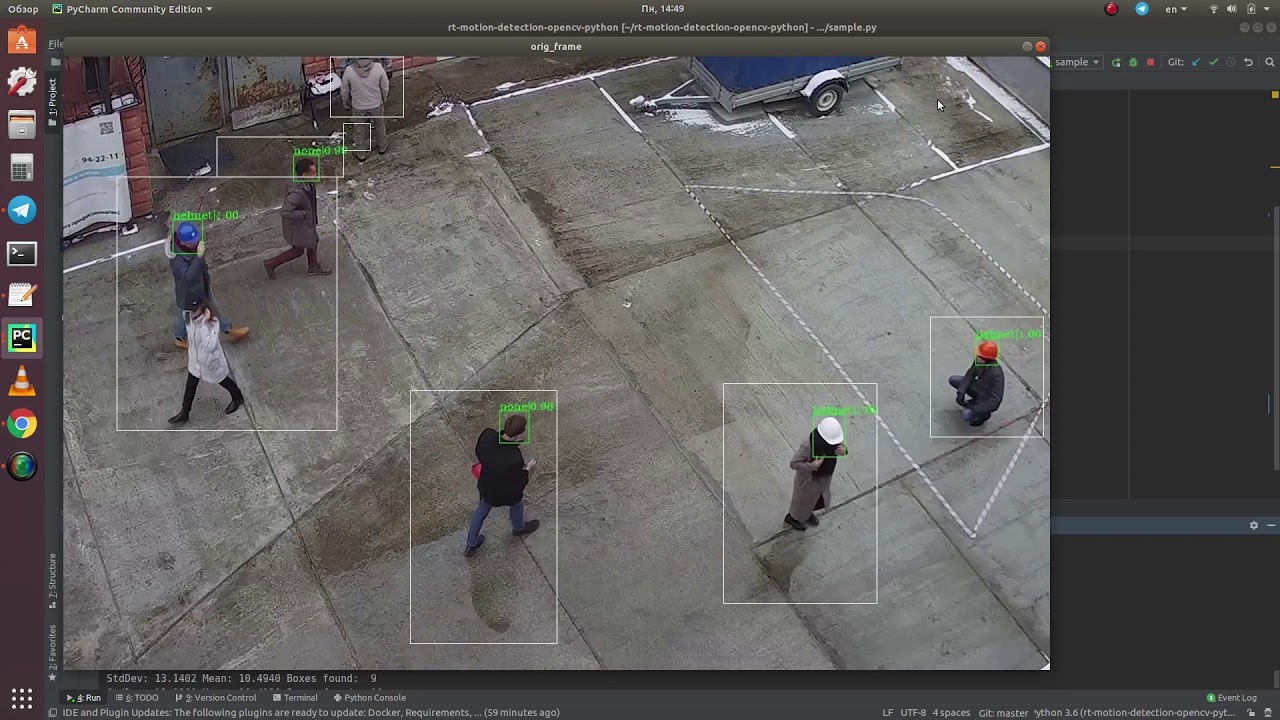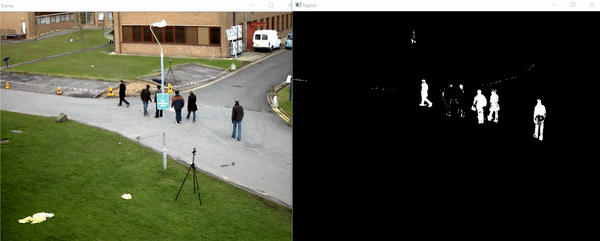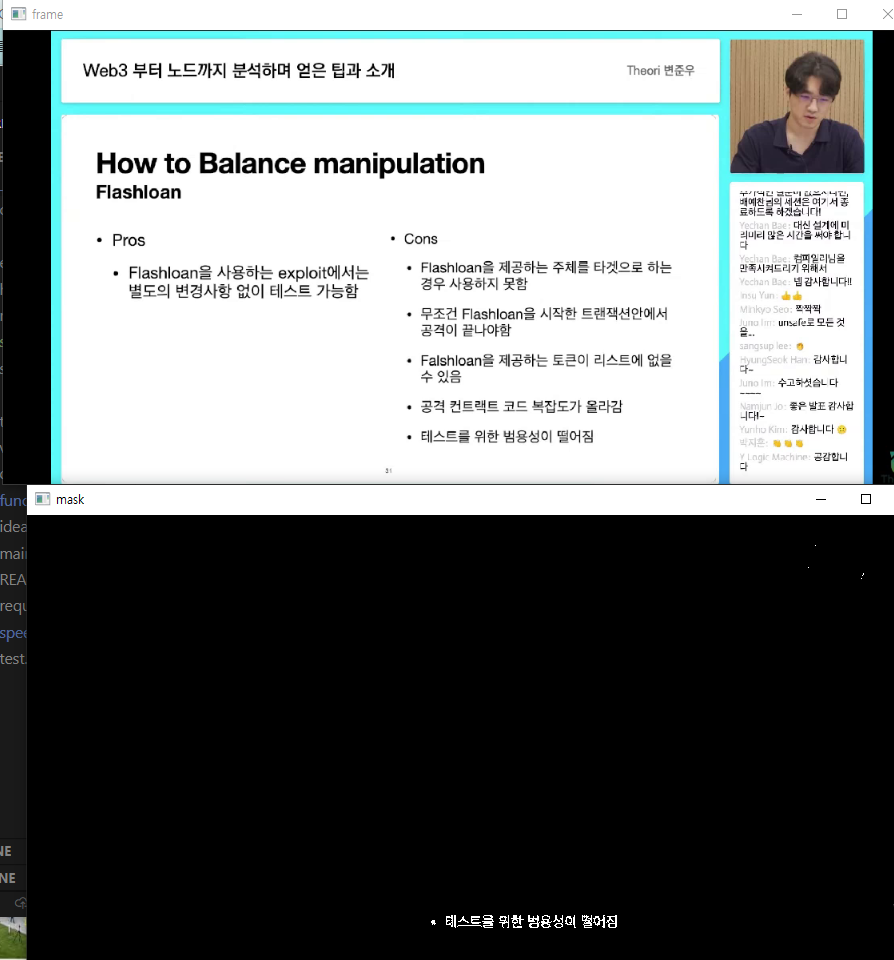Feature of Motion change detection
Machine Learning Project
EDU_Siri provides a feature that converts lecture PPT slides into text.
To convert PPT slides into text, it is essential to detect changes in the slides. If there are any changes, the system captures an image of the slide, extracts the text using OCR, and saves it as a text file.
Here, the function responsible for detecting changes in the PPT content and capturing the screen when movement is detected is called motion change detection.
Motion capture has many well-established references, so there was no need to significantly modify or implement a new algorithm.
However, using standard example code resulted in excessive frame-by-frame image saving, leading to unnecessary storage consumption and performance optimization issues. To address this, I modified the code to check for motion changes and save frames every two seconds.
1. Load Video File & Basic Setup
1
2
3
4
5
6
7
8
9
10
11
12
13
14
15
16
17
18
19
cap = cv.VideoCapture(video_name)
fgbg = cv.createBackgroundSubtractorMOG2(history=500, varThreshold=500, detectShadows=0)
# Setting up to capture images at specified intervals
start_time = int(time.time())
i = 0 # File naming index
while True:
instant_time = int(time.time())
# Get the current frame count and total frame count
if cap.get(cv.CAP_PROP_POS_FRAMES) == cap.get(cv.CAP_PROP_FRAME_COUNT):
break
ret, frame = cap.read()
width = frame.shape[1]
height = frame.shape[0]
frame = cv.resize(frame, (int(width * 0.8), int(height * 0.8))) # Resize the display frame
2. Subtract Background & Get Object Information
1
2
fgmask = fgbg.apply(frame) # Background subtraction
nlabels, labels, stats, centroids = cv.connectedComponentsWithStats(fgmask)
The goal is to detect motion changes in objects within the video. Since other elements are unnecessary, we use fgbg.apply() to remove all background elements, leaving only the moving objects.
The connectedComponentsWithStats() function retrieves four key elements:
1
2
3
4
retval
label - Label map where each object is assigned a number
stats - N x 5 matrix (N = number of objects + 1), each row represents an object with (x, y) top-left coordinates and area
centroid - N x 2 matrix representing the center of mass (x, y) coordinates
To detect object motion, we only need three factors: total area change, coordinate change, and center of mass change. Thus, we extract stats and centroids.
3. Check Object Motion & Save Frame
1
2
3
4
5
6
7
8
9
10
11
12
13
14
for index, centroid in enumerate(centroids):
if stats[index][0] == 0 and stats[index][1] == 0:
continue
if np.any(np.isnan(centroid)):
continue
x, y, width, height, area = stats[index]
centerX, centerY = int(centroid[0]), int(centroid[1])
# Detect motion based on area
if area > 400:
if instant_time > start_time + 2:
cv.imwrite("%s/%s.png" % (dir_name, i), frame)
start_time = instant_time
We compare the obtained object motion values with the area threshold. If it exceeds a certain value, the system captures a screenshot and saves it to a file.
Full Code
1
2
3
4
5
6
7
8
9
10
11
12
13
14
15
16
17
18
19
20
21
22
23
24
25
26
27
28
29
30
31
32
33
34
35
36
37
38
39
40
41
42
43
44
45
46
47
48
49
50
51
52
53
54
def motion_change_detection(video_name, dir_name) -> str:
base_path = os.getcwd()
video_name = base_path + "\\video\\" + str(video_name)
cap = cv.VideoCapture(video_name)
fgbg = cv.createBackgroundSubtractorMOG2(history=500, varThreshold=500, detectShadows=0)
start_time = int(time.time()) # Set capture interval
i = 0 # File naming index
try:
while True:
instant_time = int(time.time())
if cap.get(cv.CAP_PROP_POS_FRAMES) == cap.get(cv.CAP_PROP_FRAME_COUNT):
break
ret, frame = cap.read()
width = frame.shape[1]
height = frame.shape[0]
frame = cv.resize(frame, (int(width * 0.8), int(height * 0.8)))
fgmask = fgbg.apply(frame) # Background subtraction
nlabels, labels, stats, centroids = cv.connectedComponentsWithStats(fgmask)
for index, centroid in enumerate(centroids):
if stats[index][0] == 0 and stats[index][1] == 0:
continue
if np.any(np.isnan(centroid)):
continue
x, y, width, height, area = stats[index]
centerX, centerY = int(centroid[0]), int(centroid[1])
# Detect motion based on area
if area > 400:
if instant_time > start_time + 2:
cv.imwrite("%s/%s.png" % (dir_name, i), frame)
start_time = instant_time
i += 1
cv.imshow('mask', fgmask)
cv.imshow('frame', frame)
k = cv.waitKey(30) & 0xff
if k == 27:
break
cap.release()
print("\n+==================================+")
print("| Detecting motion change is done! |")
print("+==================================+")
except OSError:
error("Failed to save file in directory that you want. Please check permission of directory or check filename")


